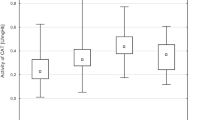Abstract
Varicose veins are a very common pathology, but the etiology is not well understood. Epidemiological studies have shown that, besides hereditary and hormonal factors, prolonged standing position may contribute to the development of this disease. The relation between the standing position and the typical physiopathological modifications of the varicose veins is still unclear (Beaglehole, dy1986; Michiels et al., 1994).
Access this chapter
Tax calculation will be finalised at checkout
Purchases are for personal use only
Preview
Unable to display preview. Download preview PDF.
Similar content being viewed by others
References
Albini A (1980) Standardizatione di un metodo di dosaggio dei gruppi tiolici-SH nel sero umano a seguito di alcune considerationi cinetiche, Boll Soc It Biol Sper LVI: 1892–1898.
Beaglehole R (1986) Epidemiology of varicose veins. World J Surg 10:898–902.
Bolzan AD, Bianchi MS, and Bianchi NO (1997) Superoxide dismutase, catalase and glutathione peroxidase activities in human blood: influence of sex, age and cigarette smoking. Clin Biochem 30:449–454.
Bradbury AW, Murie JA, and Ruckley CV (1993) Role of the leucocyte in the pathogenesis of vascular disease. Br J Surg 80:1503–1512.
Cheung P-Y and Schultz R (1997) Glutathione causes coronary vasodilation via a nitric-oxide and soluble guanylate cyclase-dependent mechanism. Am J Physiol 273, H1231–H1238.
Ciuffetti G, Mannarino E, Paltriccia R, Malagigi V, Sergi F, Paulisch P, Pasqualini L, and Lupattelli G (1994) Leucocyte activity in chronic venous insufficiency. Int Angiol 13(4):312–316.
Coleridge-Smith PD, Thomas P, Scurr JH, and Dormandy JA (1988) Causes of venous ulceration: a new hypothesis. Br Med J 296:1726–1727.
Dormandy JA (1995) Influence des éléments figures et du flux sanguin sur l’endothélium veineux. Phlébologie 48, special issue: 137–140.
Flagg EW, Coates RJ, Jones DP, Eley JW, Gunter EW, Jackson B, and Greenberg RS (1993) Plasma total glutathione in humans and its association with demographic and health-related factors. Br J Nutr 703:797–808.
Fulbert JC and Cals M-J (1992) Les radicaux libres en biologie clinique: origine, role pathogene et moyens de defense. Path Biol 40,1:66–77.
Gerard-Monnier D and Chaudiere J (1996) Métabolisme et fonction antioxydante du glutathion. Path Biol 44,1:77–85.
Halliwell B, Gutteridge JMC, and Cross CE (1992) Free radicals, antioxidants, and human disease: Where are now?. J Lab Clin Med 119,6:598–620.
Halliwell B (1996) Mechanisms involved in the generation of free radicals. Path Biol 44,1:6–13.
Harlan JM, Levine JD, Callahan KS, Schwartz BR, and Harker LA (1984) Glutathione redox cycle protects cultured endothelial cells against lysis by extracellularly generated hydrogen peroxide. J Clin Invest 73:706–713.
Iwao T, Toyonaga A, Shigemori H, Sumino M, Oho K, and Tanikawa K (1995) Microcirculation in venous disorders: the role of the white blood cells. Int J Microcirc Clin Exp 90:3–8.
Johnston B, Kanwar S, and Kubes P (1996) Hydrogen peroxide induces leukocyte rolling: modulation by endogenous antioxidant mechanisms including NO. Am J Physiol 40, H614–H621.
Kugyiama K, Ohgushi M, Motoyama T, Hirashima O, Soejima H, Misumi K, Yoshimura M, Ogawa H, Sugiyama S, and Yasue H (1998) Intracoronary infusion of reduced glutathione improves endothelial vasomotor response to acetylcholine in human coronary circulation. Circulation 97:2299–2301.
Li RK, Shaikh N, Weisel R, Tumiati L, Wu TW, and Mickle D (1992) Cultured vascular endothelial cell susceptibility to extracellularly generated oxidant injury. J Mol Cell Cardiol 24(6): 595–604.
Mezzetti A, Di Ilio C, Calafiore AM, Aceto A, Marzio L, Frederici G, and Cuccurullo F (1990) Glutathione peroxidase, glutathione reductase and glutathione transferase activities in the human artery, vein and heart. J Mol Cell Cardiol 98:935–938.
Michiels C, Arnould T, and Remacle J (1994) Role de l’hypoxie et des cellules endotheliales dans le developpement des veines variqueuses. Med Sci 10:845–853.
Michiels C, Arnould T, Janssens D, Bajou K, Geron I, and Remade J (1995) Interactions entre les cellules musculaires lisses apres activation par l’hypoxie. Une etiologie possible de la maladie veineuse. Phlebologie 48:141–149.
Michiels C, Arnould T, Janssens D, Bajou K, Geron I, and Remacle J (1996) Interactions between endothelial cells and smooth muscle cells after their activation by hypoxia. A possible etiology for venous disease. Int Angiol 15:124–130.
Michiels C, Arnould T, Thibaut-Vercruyssen R, Bouaziz N, Janssens D, and Remacle J (1997) Perfused human saphenous veins for the study of the origin of varicose veins: role of the endothelium and of hypoxia. Int Angiol 16:134–141.
Mickle DA, Li RK, Weisel RD, Tumiati LC, and Wu TW (1990) Water-soluble antioxidant specificity against free radical injury using cultured human ventricular myocytes and fibroblasts and saphenous vein endothelial cells. J Mol Cell Cardiol 24:1297–1304.
Moyses C, Cederholm-William SA, and Michel CC (1987) Haemoconcentration and accumulation of white cells in the feet during venous stasis. Int J Microcirc Clin Exp 5:311–320.
Robert A (1992) Extracellular matrix and vascular pathologies. Role of proteases and oxygenated free radicals. Ann Cardiol Angiol 24:Al8–A23.
Saharay M, Addison IE, Shields DA, Scurr JH, and Coleridge-Smith PD (1996) Leukocyte migration in the leg in response to experimental venous hypertension. J Vasc Surg 24:725–731.
Saharay M, Shields DA, Porter JB, Scurr JH, and Coleridge-Smith PD (1997) Leukocyte activity in the microcirculation of the leg in patients with chronic venous disease. J Vasc Surg 25:265–273.
Scott HJ, Cheatle TR, McMullin GM, Coleridge-Smith PD, and Scurr JH (1990) Reappraisal of the oxygenation of blood in varicose veins. Br J Surg 77:934–936.
Thomas PR, Nash GB, and Dormandy JA (1988) White cell accumulation in dependent legs of patients with venous hypertension: a possible mechanism for trophic changes in the skin. Br Med J 27:1693–1695.
Author information
Authors and Affiliations
Editor information
Editors and Affiliations
Rights and permissions
Copyright information
© 1999 Springer Science+Business Media New York
About this chapter
Cite this chapter
Siska, IR., Avram, J., Tatu, C., Bunu, C., Schneider, F., Maties, R. (1999). Some Aspects Concerning the Antioxidant Capacity of Venous Blood in Lower Limbs Varicose Veins. In: Eke, A., Delpy, D.T. (eds) Oxygen Transport to Tissue XXI. Advances in Experimental Medicine and Biology, vol 471. Springer, Boston, MA. https://doi.org/10.1007/978-1-4615-4717-4_54
Download citation
DOI: https://doi.org/10.1007/978-1-4615-4717-4_54
Publisher Name: Springer, Boston, MA
Print ISBN: 978-1-4613-7137-3
Online ISBN: 978-1-4615-4717-4
eBook Packages: Springer Book Archive



